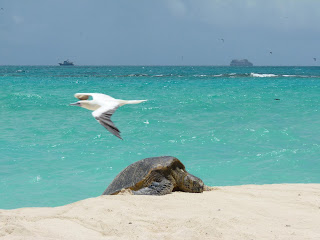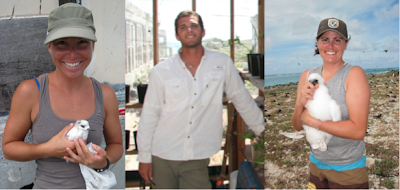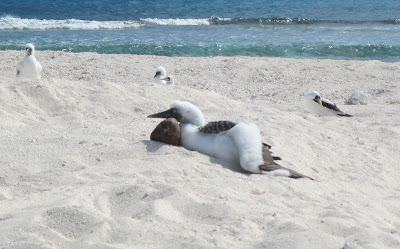The honu are hatching now! Every morning we walk along the runway, to find Hawaiian green sea turtle hatchlings that have lost their way during the night.
 |
| Honu hatchling. Photo by Mark Sullivan |
Because Tern Island is basically a man-made island with a lot of vegetation, structures, and other things that turtles wouldn't normally encounter on a sandy island -- and that they don't run into on any of the other islands in the atoll -- we have to make sure those that get waylaid along the way have a chance to get back out at sea. Right now we check every morning, and release those hatchlings back into the sea. Only about one in a thousand will make it all the way to being an adult turtle, but we figure if we save 1,000 hatchlings, that's kind of like saving one adult turtle.
This fall, after most of the seabirds have left, the crew will be moving a 12" PVC pipe to the inland side of the beach. The pipe acts as a fence for the hatchlings, so should help more of lost ones find their way back to the sea, rather than get lost in Tern's vegetation. This should further help the honu towards recovery.
 |
| Honu hatchling ponders the great moana. Photo by Mark "Sissy" Sullivan. |
The Christmas Shearwater (
Puffinus nativitatis) chicks are also growing! Most of them have some feathers now. They are funny looking chicks, with a big fat body and little tiny head. The adults are all dark brown to black, with a tube-nose for getting rid of salt. They're about as big as both of your hands cupped together. They arrive at Tern in February, and lay their eggs in March. Its difficult to get good photos of them because they roost and nest in very dark areas under leafy bushes, and leave the island soon after it gets light. They are very skittish, and will fly away if you come near them.
 |
| Christmas in a bush. Photo from FWS file. |
Christmases breed on islands throughout the central and south Pacific, although we don't know very much about how many there are or how they are doing as a species. Christmases need good shade for roosting and nesting (on Tern, they sleep and nest only under healthy leafy bushes), and have no defense against rats, cats or other predators. Christmases also breed on some of the small offshore islands in the Main Hawaiian Islands - so we have to be sure to keep those areas rat-free!
Mostly we see Christmas Shearwaters in the early morning, when they come out from under shrubs to bask in the morning light. Although Christmases are never very numerous in one location, they are social in the morning, and usually sit in couples, 3s or 4s together, preening in the morning light. After they warm up, they take off for a day of fishing before returning in the evening.
 |
| Merry Christmas! Christmas Shearwaters are very affectionate with each other, and usually spend the early morning hours basking in the sun and preening each other. Photo from FWS files. |
Christmases are one of my favorite birds because they are so gentle with each other, and quiet when you catch them. Although they kind of howl at night like Wedge-tailed Shearwaters, they only howl once or twice, and then quiet down -- They don't go on and on for hours, like Wedgies do. When you catch a Christmas (as for banding), they peep rather pitifully, but don't try to peck your eyes out or bite you, as many birds do.
 |
| Seal pup REALLY close up.... Photo by Mark Sullivan. |
Traditional Hawaiian cultural practitioner Leighton Tseu has been working with the seal crew these last two weeks. Uncle has shared lots of stories with us, and reminded us why we are out here. We will be in his debt for a long, long time. Thank you, Uncle Leighton!!! We have very much enjoyed having you here. The seal crew has taken down their camp, and are getting ready to leave the atoll sometime next week.
 |
| Gratuitously cute seal pup photo, by Guess Who. (yes, Mark Sullivan) |
 |
| Swan Lake with Net. Ben Cook and Mark Sullivan provide interpretive marine debris dance. |
I will be leaving Tern Island this week (very sadly for me). The good news is that the new Assistant Manager, Meg Duhr Schultz, will be taking over. She will supply you with lots of good stories and news about the birds, seals, and turtles until my return to Tern in December. Meg, Erin and Scott will continue here until that time -- Be safe, Meg, Erin, and Scott, and great adventures!
 |
| Paula before departure.... |
 |
| After Departure.... The vessel Searcher, taking Paula away.... and Life in the Atoll continues. |
 Okay, okay, you've probably all seen the sign before, especially if you've ever 'googled' us or even been to Tern Island yourself, but I couldn't resist. And true to Tern Island form, note the duct-tape signage updates made on recycled Rite-in-the-Rain paper. Next we'll have to update the airport section to say "temporarily closed due to budget cuts." But that's a whole other story...
Okay, okay, you've probably all seen the sign before, especially if you've ever 'googled' us or even been to Tern Island yourself, but I couldn't resist. And true to Tern Island form, note the duct-tape signage updates made on recycled Rite-in-the-Rain paper. Next we'll have to update the airport section to say "temporarily closed due to budget cuts." But that's a whole other story...





















